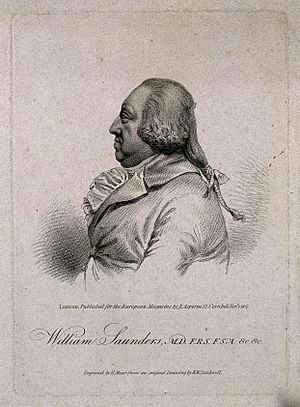William Saunders (physician) facts for kids
Quick facts for kids
William Saunders
|
|
|---|---|

William Saunders
|
|
| Born | 9 July 1743 Banff, Scotland
|
| Died | 4 June 1817 (aged 73) |
| Occupation | Physician |
| Title | |
William Saunders (born July 9, 1743 – died June 4, 1817) was a Scottish doctor. He was a very important figure in medicine and became the first president of a group called the Royal Medical and Chirurgical Society. This society helped doctors share new ideas and research. He was also a member of the Royal Society of London and the Royal Society of Edinburgh, which are famous groups for scientists.
Contents
Early Life and Education
William Saunders was born on July 9, 1743, in a town called Banff in Scotland. His father, James Saunders, was also a doctor.
When William was 12 years old, he started studying science at Marischal College in Aberdeen. This was normal for young people back then. After that, he went to the University of Edinburgh to study medicine. He learned from a famous doctor named William Cullen. William Saunders even became Dr. Cullen's assistant.
In 1765, he earned his medical degree. For his final project, he wrote about how a substance called antimony could be used in medicine.
Moving to London and Important Discoveries
After finishing his studies, William Saunders moved to London. He started by teaching chemistry and how to prepare medicines in private schools.
He became well-known for solving a medical mystery. At the time, many people in Devonshire were getting sick with a painful stomach problem called colic. Some thought it was from drinking too much cider. But William Saunders did experiments and proved that the problem was actually lead poisoning. The lead was dissolving into the cider during the making process. This showed how important it was to understand what caused illnesses.
Working at Guy's Hospital
In 1769, William Saunders became a Licentiate of the Royal College of Physicians. This meant he was officially allowed to practice medicine. The next year, in 1770, he became a doctor at Guy's Hospital. This was a big hospital in London.
At Guy's Hospital, he created and taught medical courses. He helped train many new doctors.
Important Roles and Recognitions
William Saunders was recognized for his hard work and knowledge.
- In 1790, he became a Fellow of the Royal College of Physicians. This is a high honor for doctors.
- In 1792, he gave a special lecture about liver diseases.
- Also in 1792, he was chosen as a Fellow of the Royal Society of Edinburgh, another important scientific group.
- In 1793, he became a Fellow of the Royal Society, one of the oldest and most respected scientific organizations in the world.
- He was also a member of the Anatomical Society and the Geological Society.
In 1802, he left Guy's Hospital. He suggested that Dr. William Babington take his place.
Leading Medical Societies
William Saunders helped start the Royal Medical and Chirurgical Society. In 1805, he was chosen as its very first president. This society played a key role in sharing medical research and improving healthcare.
He also mentored other doctors, like Rev. Dr. Sayer Walker.
In 1807, he was appointed as a special doctor to Prince George Augustus Frederick. This prince later became King George IV.
Throughout his career, William Saunders wrote many books and papers about different medical topics. He helped spread new medical knowledge.
Later Life
William Saunders retired in 1814. He passed away in Enfield, London on June 4, 1817. He is buried in the churchyard at Enfield Parish Church.
Family Life
William Saunders was married twice. He had four sons and two daughters.

